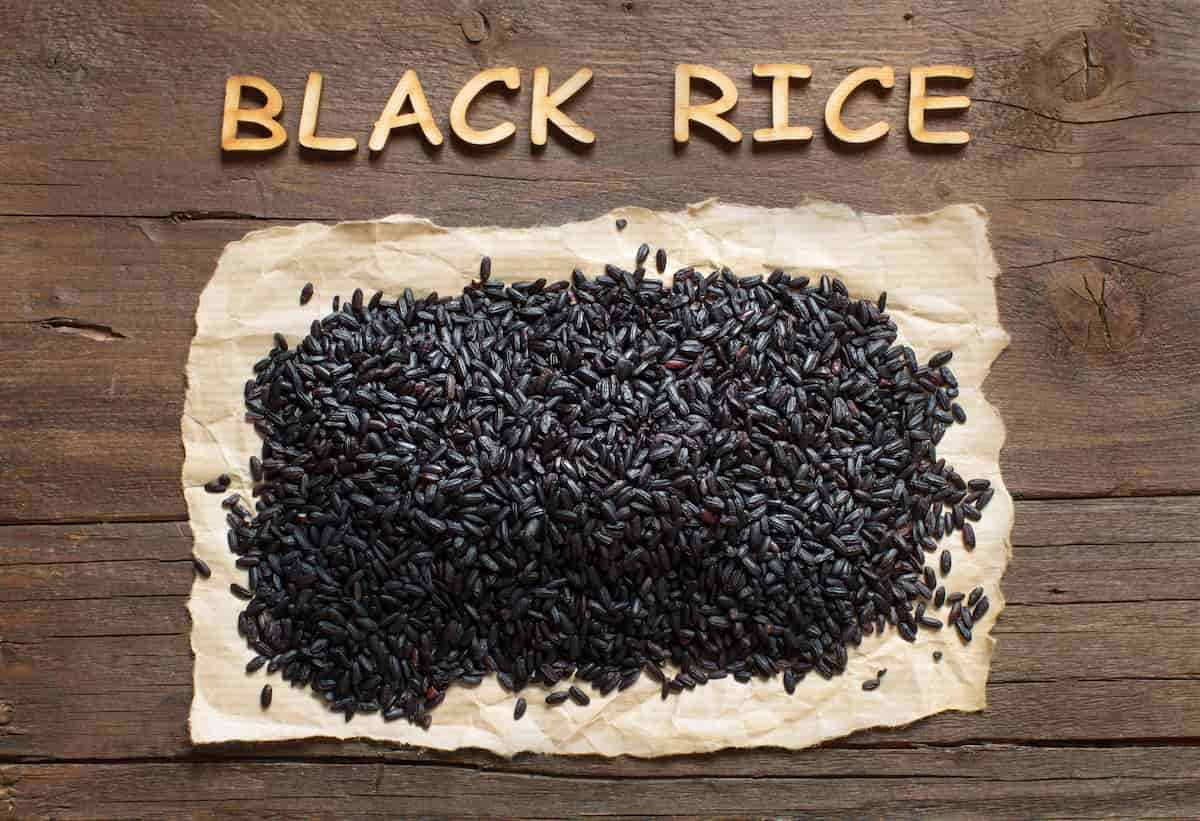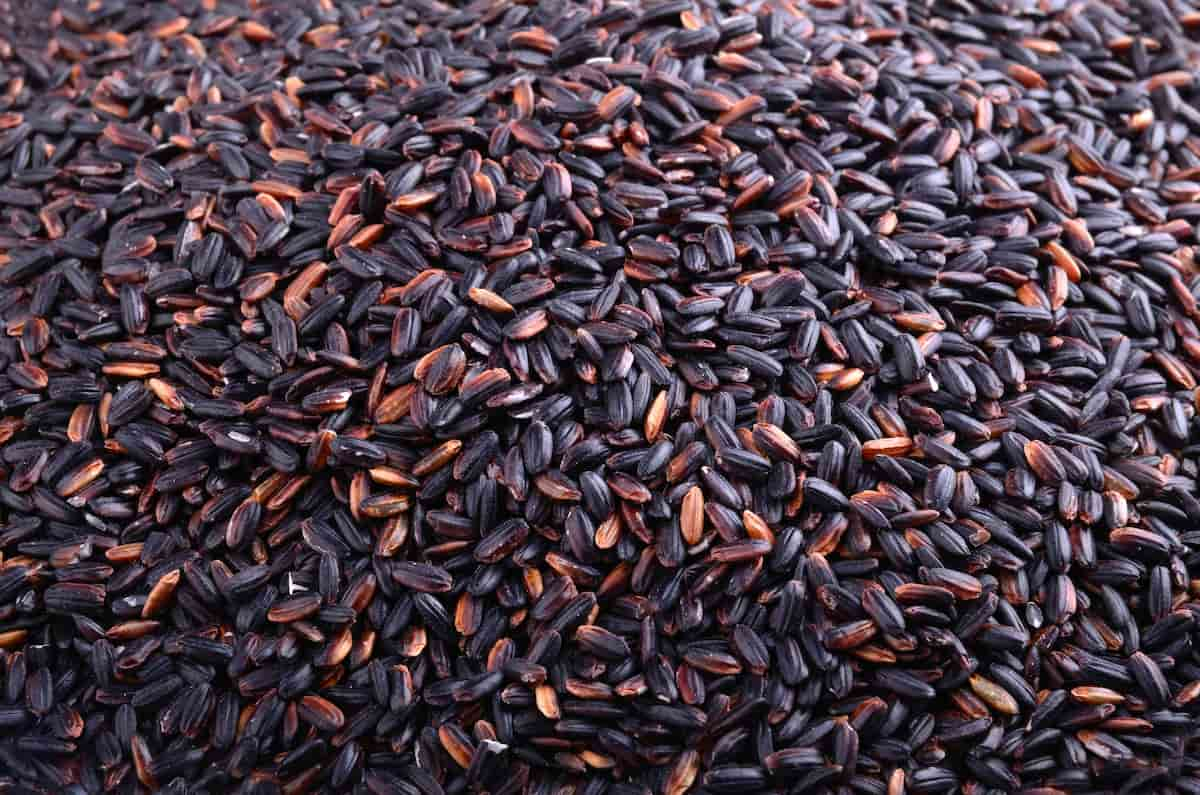Black rice farming, commonly referred to as forbidden rice farming, is a long-standing tradition that has become more well-known recently. This variety of rice is particularly distinctive not only for its striking color but also for the numerous health advantages that make it a preferred option for consumers worldwide. The characteristics of black rice, the best production package techniques for black rice farming, the benefits of best production package practices, and problems and solutions in black rice farming will all be covered in this blog.

Black Rice Farming
What is Black Rice Farming?
Black rice farming cultivates rice commonly known as “forbidden rice” or “purple rice.” It is a type of rice grown for centuries in various world regions, including Asia and Africa. Historically, black rice was reserved only for the wealthiest and most powerful people due to its unique nutritional properties and rarity. It has become more widely available today and is gaining popularity because it is a healthier alternative to traditional white rice.
- Black rice gets its color from anthocyanins, powerful antioxidants also found in blueberries, raspberries, and other dark-colored fruits and vegetables. These anthocyanins provide a range of health benefits, including reducing inflammation, improving cardiovascular health, and lowering the risk of certain types of cancer.
- In addition to its nutritional benefits, black rice has a distinct and delicious flavor often described as nutty or earthy. It is also known for its slightly chewy texture, making it a popular ingredient in rice salads, sushi rolls, and rice bowls.
Characteristics of Black Rice
- High Nutritional Value: Black rice is a rich source of antioxidants, vitamins, minerals, and fiber. It contains more protein and fiber than white rice, making it a healthier choice.
- Unique Flavor and Aroma: Black rice has a nutty flavor and a sweet aroma that sets it apart from other rice varieties.
- High Anthocyanin Content: Black rice owes its dark color to anthocyanins, a group of flavonoids with powerful antioxidant properties. These compounds are known to reduce the risk of chronic diseases.
- Slow Digestion: Black rice has a low glycemic index, which means it is slowly digested and absorbed in the body. This helps in regulating blood sugar levels and maintaining energy levels.
- Gluten-free: Black rice is a gluten-free grain, making it an ideal choice for people with gluten sensitivity or celiac disease.
- Long Shelf Life: Black rice has a longer shelf life than other rice varieties due to its high antioxidant content.
Production Package Practices for Black Rice Farming
Soil Selection and Field Preparation
Black Rice can be grown in various soils, but clay loam soils with good water-holding capacity are considered best for black rice cultivation. After summer plowing, the soil should be prepared by ploughing 2-3 times. To save and hold onto water, bundling should be maintained. If Dhaincha was grown as a previous crop for green manuring, phosphorus should be added to the soil. The field should be watered at least one week before transplanting to allow weeds to grow. The area should be plowed by filling water and puddling before the black rice seedlings are transplanted.
Black Rice Varieties and Seed Rate
Several Black Rice varieties are available, including Krishnavrishi, Barmablack, Kalabatt, and Kalabattu. Farmers can obtain Black Rice seeds from other farmers. The recommended seed rate for Black Rice farming is 20-25 kg of Black Rice seed per hectare of fine, 30-35 kg seed for medium, and 35-40 kg seed for coarse Black Rice seeds in the nursery to transplant in 1 ha or 2.45 ac land.
Nursery Raising and Management
To raise the Black Rice nursery, prepare 80-100 plots of 1.25m x 8.0m (10 sqm) with a 4-inch height. Use 220gm of urea and 312.50gm of SSP (100kg N and 50kg P) per nursery patch. A nursery of 800-1000 sqm is sufficient for transplanting on a hectare of land. Trichoderma biopesticide should be sprayed within ten days after sowing the nursery. To control whitening, use 4 kg ferrous sulfate with 20 kg urea per hectare. Use 500 gm Carbendazim 50% WP per hectare to control the Black Rice blast. Use 2 kg zinc manganese carbamate per hectare to prevent brown spot disease.
Insect Pest Management
To protect the crop from insect pests, spray 1 lt Fenitrothion 50EC or 1.25 lt Quinolphos 25EC, or 1.5 lt Chloropyriphos 20EC per hectare.
Seed Treatment
Before sowing the seed in the nursery, treat the seed with 4 gm streptocyclin sulfate per 25 kg seed or use 40 gm plantomycin to control Bacterial blight. Generally, seed treatment is done by making a solution of 75 gm thiram or 50 gm carbendazim in 8-10 lt water to treat 25 kg seed. Before planting it in the nursery, briefly dip the seed and let it germinate. The seed can also be treated with trichoderma biopesticide at a rate of 125 grams per 25 kg of seed.
Fertilizer Management
Add NPK at 120:60:60 kg/ha for early maturing, 140:70:70 kg/ha for medium maturing, and 160:80:80 kg/ha for late maturing. Apply half the dose of nitrogen and a full dose of phosphorus and potassium before transplanting as basal dressing. The remaining dosage of nitrogen should be used in two installments during tillering and ear emergence as a top dressing. A spray of zinc and iron is also essential for better nutrient uptake and plant growth.
In case you missed it: Benefits of Rice Water in Your Garden: Apply for Potted, Terrace, Indoors, and Backyard Plants

Transplanting and Spacing in Black Rice
Transplant Black Rice seedlings 20-22 days old into the field, maintaining a spacing of 20x15cm or 20x10cm with a depth of 3-4cm. It is recommended to transplant 2-3 black rice plants per hill for better yield. In case of gaps, fill them by replacing the dead plant with a new one to maintain the proper plant population.
Weed Management Black Rice
Effective weed management is essential for the healthy growth of Black Rice. In the 48 hours after sowing in the nursery at the appropriate moisture, combine Pretilachlore 30.7% EC @1.25lt with 15-20kg sand and broadcast it per hectare. Use Nominee Gold (bipyribeg sodium) at a rate of 100 gm/acre 10 days after transplantation when the field is moist.
Water Management
Proper water management is crucial for Black Rice farming. In the absence of rainfall, irrigate the crop during tillering, ear emergence, flowering, and grain-filling stages.
Plant Protection in Black Rice
Black Rice is vulnerable to several insect pests and diseases, such as root weevil, leaf roller, husk insect, sheath blight, bacterial blight, and false smut. In time, CIBRC recommended effective and safe insecticides, pesticides, fungicides, and bactericides to protect crops from pests and diseases.
Harvesting in Black Rice
Harvest Black Rice when all the seeds turn completely black. The harvesting period of Black Rice is between 110 to 130 days after transplanting. A harvester machine can also be used for Black Rice harvesting.
Benefits of Best Production Package Practices
- Increase in crop yield
- Improvement in soil fertility
- Reduction in input cost
- Better pest and disease management
- Consistent and high-quality crop production
- Reduction in post-harvest losses
- Enhanced crop resilience to climate change
- Improved food security and nutrition
- Increase in farm income
- Sustainable agriculture practices and environmental conservation
Challenges and Solutions in Black Rice Farming
Black Rice farming faces challenges such as poor seed quality, unbalanced soil fertility, improper water management, pests and diseases, weed control, improper harvesting, limited market availability, climate change, labor shortage, and limited access to finance.
Solutions
- Using high-quality seeds.
- Conducting soil tests.
- Implementing proper irrigation methods.
- Using recommended insecticides and fungicides.
- Promoting Black Rice as a specialty product.
- Selecting suitable varieties.
- Using labor-saving technologies.
- Accessing government schemes for finance and credit.
In case you missed it: Paddy/Rice Production Guide: A Step-By-Step Cultivation Practices

Conclusion
Unlocking the potential of Black Rice farming requires adopting best production package practices such as using high-quality seeds, balanced fertilizers, proper water management, pest and disease management, weed control, appropriate harvesting, and threshing, and marketing strategies to enhance profitability and sustainability.
- Feed Your Flock for Less: Top 10 Tips to Save on Chicken Feed
- Ultimate Guide to Ossabaw Island Hog: Breeding, Raising, Diet, and Care
- Hatching Answers: The Top 10 Reasons Your Chickens Aren’t Laying Eggs
- Eggs and Economics: Breaking Down the Cost of Raising Backyard Chickens
- Defend Your Greens: Proven Methods to Keep Iguanas Out of Your Garden
- Ultimate Guide to Cinnamon Queen Chicken: A Comprehensive Guide for Beginners
- Ultimate Guide to California Tan Chicken: Breeding, Raising, Diet, Egg-Production and Care
- Ultimate Guide to Marsh Daisy Chicken: Breeding, Raising, Diet, and Care
- 10 Types of Chicken Farming Businesses You Can Start for Profits